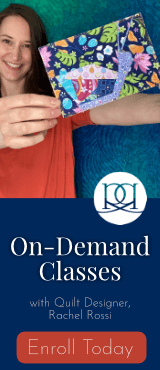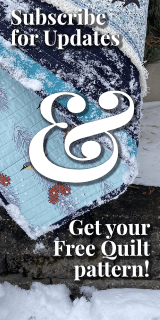Cutting Day!
Today is cutting day! Hip Hip Horray!
Now, if you’re using gorgeous gradient or ombre fabrics (like what I’m using from Jennifer Sampou’s collection, Sky) there’s a few tips and tricks that I have for you before you get started (see my post on how to work with gradients here). If you’re just going with prints or solids, you don’t have to worry about much!

Before you get cutting, make sure you chose which direction your strips are going (pointing up like silos or down like raindrops) and which fabrics coordinate with prints A—G. If you didn’t do that yet, head back to Day 1 of the Sew Along!

Time to Cut
Because I might lose some of you here, don’t miss this:
MAKE SURE YOU MARK YOUR PIECES!!!
I went to great lengths to make sure that each piece is labeled on the pattern so that things don’t get too messy here. It only works if you’ve labeled your pieces though!

Like I said earlier, if you’re not doing anything fancy with directional prints or gradients in your fabrics, you can just follow the instructions and get started! For those of us using gradients, we have a few special things to keep in mind…
Cutting with Gradients
Because the rounded end of each strip is sewn on separately, we want to make sure that we continue the gradient from strip to rounded end. If you follow the instructions, there’s a good chance that you’ll end up with random colors coming together and the illusion won’t work. For this to happen, we need to do a few things differently:

1. Cut strips a *little* wider
To keep the gradient illusion going, I cut the half circles and strips at the same time from the same strip. In order to have a wide enough strip to do that, I had to cut each strip just a tiny bit wider than listed in the pattern. So, for Baby quilts, cut your 3-1/2″ strips at 3-5/8″. For Throw and Twin sizes, cut 4-5/8″ strips, rather than 4-1/2″ strips.
Keep in mind, that if you cut one strip wider, ALL the strips need to be cut to the same size.
Because of the change we’re making in step 2 (below), you won’t need to cut the second set of strips listed under each fabric (4-1/2″ strips for baby sizes and 5-1/2″ strips for throw/twin sizes)
Also, keep in mind, if you end up working ahead of the sew along, you’re going to need to adjust your 1/4″ seam...More on that next week!
2. Cut ovals and strips at the same time
Now that my strips are cut to the right width, we can get to cutting the strips and half ovals.
It helps to take a read through page 11 before getting started so that you can see where we are headed with this…rather than cutting whole circles, we’ll be cutting half circles so that we can have more control over the color on each piece. Simply cut out and fold your template in half along the center line. If you have any non-gradient fabrics, make sure to cut full ovals out to save yourself some time.
First cut the first strip listed, keeping in mind that you will be cutting your oval next, so if you want the “drips” to be darkest at the bottom, then you’ll want to make sure that you’re leaving room at the darkest end of the strip for your half-oval.

… Then cut out a piece large enough to fit your half oval onto.

LABEL LABEL LABEL! I labeled each piece with their corresponding number. This ensured that I wouldn’t get anything mixed up and the gradient wouldn’t get lost in my piecing!
Continue cutting in this way for all pieces. I know it’s a bit tedious, but it’s totally worth it once you see the quilt coming together!
Piecing with Gradients
A special note for those of you doing twin sized quilts; there are a few long strips that you’ll have to piece together. Don’t worry, this won’t ruin the illusion! Just do your best to join the two strips together where the gradients match so that the illusion isn’t lost!
Tracing Time!
I threw this in with the cutting week so that next week we can go right to sewing!
Grab your Wash-n-gone stabilizer and trace those half-ovals onto it. I liked cutting small rectangles so that they were easy to work with. If you’re using any non-gradients, just follow the directions and cut a full oval- it makes things a lot more efficient!
Then, trace around the oval onto the stabilizer.
Unlike the pattern instructions, I found during this round that I actually preferred to trace onto the fabric (wrong side) while working on this. I’d suggest skipping ahead and doing a test run on your machine to see which side you’d like facing up when you sew before tracing all these shapes! If you’re using a straight stitch plate, I found the fabric on top worked better (more on stitch plates later this week!)

Repeat, repeat, repeat! Once you’ve got everything traced, you’ll be ready to sew next week!
Show it Off
Now that all your hard work of cutting is done, show it off! If you’re excited, throw up the strips on a design wall, snap a picture, and tag me! Use #HypersonicSAL so that we can all cheer you on too. This pattern is a lot of cutting, you’ll probably need a cheer at this point, but the sewing is a BREEZE, I promise!












